John 5:24
"Home is the Sailor, Home From The Sea.... And The Hunter, Home From The Hill"

 Permission Granted To Come Aboard...
Permission Granted To Come Aboard...
..And Welcome To The Pirate's Lair!
a Division of DataCity, Inc.
Click Here and Return to The Pirate's Lair Home Page www.thepirateslair.com
OR
Click Here and Return to the Naval Cutlass Main Page

Complete and Authentic 18th and 19th Century Antique British Royal Navy Regulation Cutlasses, or Seamans Cutlass for Sea Service, Regulation Boarding Axes and Boarding Pikes, Seamens Ditty Boxes or Sea Chests, and Battle Rattles!
Photographs, History, Identification, Technical Information, Pricing and Availability
Call The Pirate's Lair @ 540-659-6209

Presented here is a collection of Authentic Regulation British Royal Navy Edged Weapons for Sea Service use from early-mid 1700s thru to the last official in-service regulation pattern, the P1901 Cutlass.

Show above is the P1804 Pattern British Royal Navy cutlass first produced in 1804 and used extensively and exclusively thoughout and aboard every ship in the Royal Navys worldwide fleet. This "figure 8" regulation cutlass made its debut at the Battle of Trafalgar, used during the War of 1812 with America, and all conflicts up until a new pattern was chosen by the Royal Navy in 1845. Click Here For Detailed Information and Photos on the Above P1804 British Royal Navy Cutlass
The British Royal Navy dominated worlds oceans and trade routes and command of the sea in large part by being the most organized and regimentally trained of all the major sea services, and its edged weapons used for boarding and repelling boarders reflected this.
The Royal Navy was one of the first navies in the 18th century to begin standardizing on the personal edged weapons used by the ordinary seaman, or Jack Tar as they were known. This standardization incuded specific technical critieria which the many cutlers needed to make, military proof inspections of the weapons with appropriate inspector and arsenal stamps.
For your review here at The Pirate's Lair we have obtained at least one of every regulation pattern of British Naval Cutlass, Boarding Pike and Boarding Ax from the late 18th to early 20th century. For the Naval Cutlass Crew we have for your review the American Revolution Figure 8 Pattern, the 1804 Pattern, the rare 1814 Pattern, 1845 Pattern, 1856 Pattern Cutlass-Bayonet, and Rare 1901 Pattern which was the last naval cutlass produced as a sea service weapon and the end of a bygone era!
Additionally we also have regulation boarding pikes and boarding axes of various patterns as documented from the 1770's thru the late 1880's by various recognized reference books. Of exceptional interest is a British Royal Navy produced (or perhaps even Colonial American made) boarding ax used during the American Revolutionary War. This boarding ax has on its wooden shaft the name "A LEWIS" which was a seaman by the name Ambrose Lewis of the American Colonial Navy just prior to and during the outbreak of conflicts, see below.
Custom Wooden Wall Brackets for the Naval Cutlass
Elegant in Their Simplicity! Custom Crafted Wooden Wall Brackets Specifically for a Cutlass Display or Sword Display for a Secure, Beautiful and Professional Presentation.
These Handcrafted Wooden Wall Brackets or Wall Mounts Are Made for the Wide and Large Hilts Normally Found on Cutlasses and Some Swords and Prevent the Hilt or Cup From Touching the Wall. The TPL Wall Brackets Come Complete with 2 Brackets and 2 Mounting Screws, and are Available in 3 Sizes with a Choice of Oak or Walnut Woods! |
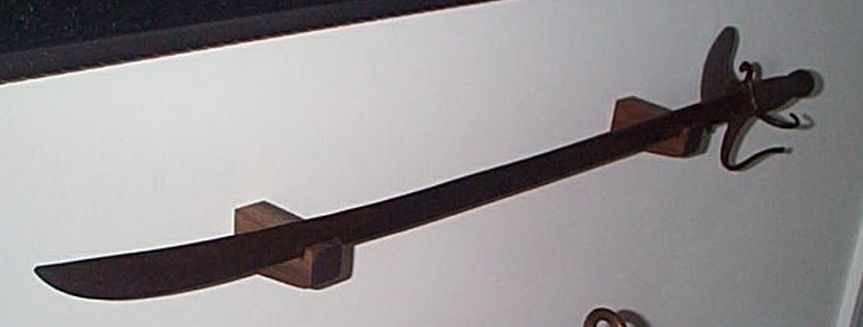
Click Photo |
$35. Pair
2.25" 2.75" 3.75"
specify length and either Oak or Walnut when calling. |
Call To Purchase
540 659 6209 |
For Your Review is Presented the British Royal Navy Sea Service Cutlass, Boarding Ax, and Boarding Pike Crew! And Battle Rattle Call To Arms! 1700s to 1901
Not Pretty, Yet Handsomely Elegant and Honest in Their Function!

1650's-1750's Above Photograph Illustrates a mid-late 17th or early 18th Century British-made Hunting Cutlass well documented and used mostly by Naval Officers as personal side arms as well as Privateers and Pirates! Yes, Pirates. Well documented in the authoritive "Boarders Away" reference guide. The maker mark on the side of the blade reads HARVEY which was a British Cutler in the family tradition making swords and cutlasses from the mid 17th thru 19th centuries.
Click Here for further more indepth Technical Characteristics, Price, and Information on this specific Colonial era hunting and naval cutlass

1750's-1790's - Above Photograph Illustrates a pre-1804 British Royal Navy marked "double disk" or figure-8 naval cutlass with round sheet metal grip and single fullered slightly curved blade marked with a Crown over GR (King George III). This was a pattern commonly found in the mid to late 18th century (1750-1796) used by both British and American navies as documented in the authoritive "Boarders Away" reference guide.
Click Here for further more indepth Technical Characteristics, Price, and Information on this specific American Revolutionary War naval cutlass

1800-1812 - Above Photograph Illustrates a very early 19th Century British or American made private purchase naval cutlass possibly used on a Privateer. The hilt is definitely of the British 1804 Figure 8 Pattern, though appearing to be a bit cruder than what one would normally see from a British cutler under contract with the Royal Navy.
The turned wooden grip and flat upturned unmarked blade do not fit with the Royal Navy's standardized sea service naval cutlass at that time so this is definitely a private purchase cutlass used aboard British or American Privateers during the Napoleonic Wars, War of 1812, and Barbary Pirate Wars. Though having definite Royal Navy characteristics it is believed that this pattern type of cutlass is actually American made due to its turned wooden grip which most English cutlers never produced.
Click Here for further more indepth Technical Characteristics, Price, and Information on this War of 1812 period War naval cutlass

1804-1845 Above photograph perfectly illustrates a P1804 Pattern Figure 8 British Royal Navy Cutlass used during the Napoleonic era with the British Empires War against the French, certainly at Trafalgar and War of 1812 with the Americans, and as a sea service weapon in all Royal Navy vessels up until 1845 when a new pattern of naval cutlass was approved. The hilt has the classic pattern 1804 Figure 8 with the bottom lobe being in a heart shape.
Grip is made of ribbed iron - this is a substantial cutlass possibly copied after and to compete with the American "Baltimore" Pattern ca 1800.
Click Here for further more indepth Technical Characteristics, Price, and Information on this 1804 Pattern British Naval Cutlass

1814-1845 Above photograph illustrates a Rare Model P1814 Pattern Figure 8 British Royal Navy Cutlass with the upturned Falchion Blade used during the Napoleonic era with the British Empires War against the French and Americans! This is only the second specimen known to have the Royal Cypher on the blade indicating government property. It is in excellent museum quality condition. The hilt has the classic Figure 8 of the model 1804 pattern but with a falchion blade and the handle on the 1814 is somewhat more sinuous and lighter than the 1804.
Grip is made of vertical ribbed iron without any intersecting horizontal lines as found on the 1804. While still a substantial cutlass it appears to be lighter and more well balanced than the 1804 pattern, a substantial improvement.
Click Here for further more indepth Technical Characteristics, Price, and Information on this 1814 Pattern British Naval Cutlass

1845-1889 Above photograph perfectly illustrates a massive original 29" P1845 Pattern British Royal Navy Cutlass. In 1889 existing servicable P1845 blades were slightly modified and shortened 2" making them the model P1889 cutlass. Note the slightly upturned blade with beveling towards the tip. The grip is made of hard leather secured with rivets.
Click Here for further more indepth Technical Characteristics, Price, and Information on this P1845 Pattern British Naval Cutlass.

1858 - Above photograph illustrates an original P1858 Pattern British Royal Navy Cutlass-Bayonet which was not readily accepted by the sea service. In an effort to save money the British Admiralty designed and introduced the P1858 Cutlass-Bayonet as a multi-purpose weapon. However this weapon was too heavy and unwieldly to be used as a bayonet and not balanced enough to be used as a cutlass.
Click Here for further more indepth Technical Characteristics, Price, and Information on this P1858 Pattern British Naval Cutlass Bayonet.
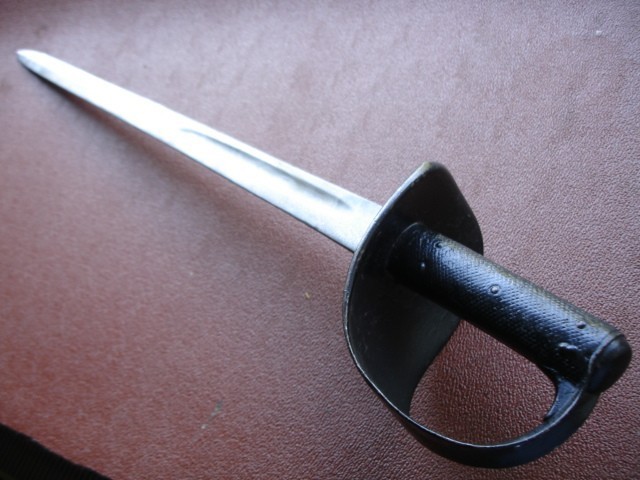
1901 Above photograph illustrates the 1901P Pattern, the last official regulation British Royal Navy Cutlass ever produced and was used as a sea service weapon in all Royal Navy vessels up until the end of WWII. Grip is made of leather secured with rivets with a blackened guard.
Click Here for further more indepth Technical Characteristics, Price, and Information on this 1901 Pattern British Naval Cutlass.

British Boarding Ax ca-1800 Found in Australia - Click Here for in depth Technical Characteristics, Photos, and Information

British Boarding Ax ca-1770s Found in U.S. Used by Colonial Navy - Click Here for in depth Technical Characteristics, Photos, and Information

British Boarding Ax P1859 Found in Canada - Click Here for in depth Technical Characteristics, Photos, and Information
The above photos illustrate rare but well documented British Royal Navy Boarding Axes used ca 1750s to mid 1800s by the British Royal Navy, American Colonial Navy, British and American Privateers. This pattern of boarding ax saw distinction from the French Indian War, American Revolution, War of 1812, Napoleonic Wars with examples found worldwide wherever the British Navy sailed!
The top photo is of a British Boarding Ax as found in Australia and the style is typically from the very late 1790s to 1850s.
The middle photo is of a British Boarding Ax with documented use between the 1750s to 1790s and found here in the US which has the name "A. Lewis" stamped onto the handle. There have been a number of boarding axes found with the "A. Lewis" stamped onto the haft, and to this date no one has identified who this was or the significance if any.
The bottom photo is of a British Boarding Ax as found in Canada and designated as the P1859 Pattern. This particular boarding ax is well marked and arsenal stamped with an 1890 manufacturing date, C&K as the producer, "broad arrow" or crows foot stamp indicating British Government Property, initials "WD" indicating War Department.
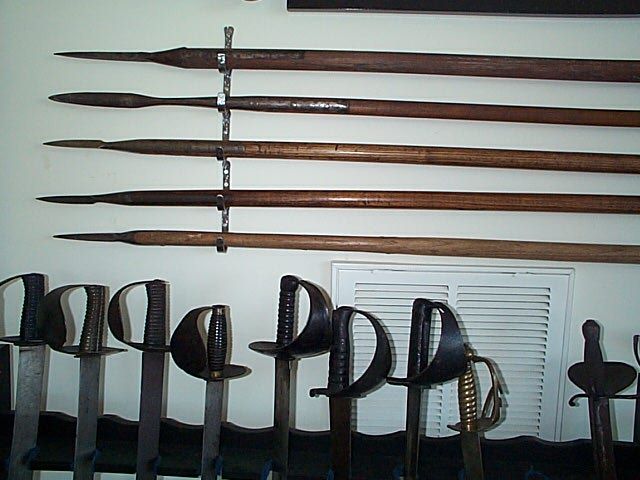
Above photograph illustrates a collection of five 18th-19th Century American Navy and British Royal Navy Boarding Pikes.
Click HERE for more information, photographs, and availability on Naval Boarding Pikes and Boarding Axes!
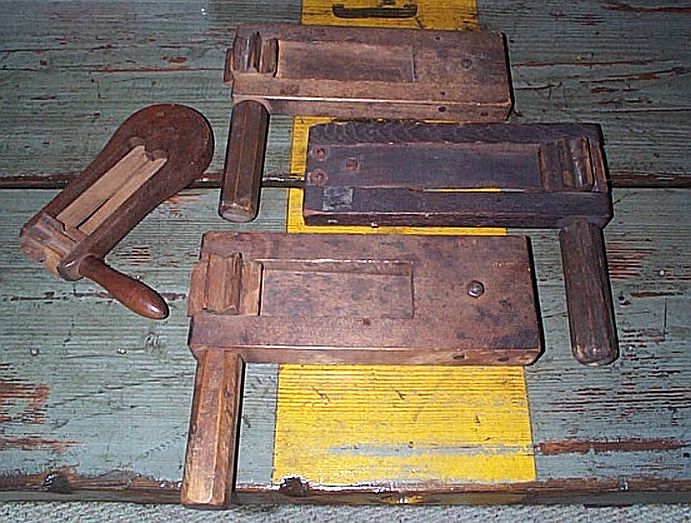
Above is a photo of four Battle Rattles - the three largest are British Royal Navy ca 19th Century while the smaller one is from the US Navy ca Civil War Era and marked with the initials "USN".
The standard battle rattle first used by the British Royal Navy in the 18th century made a LOUD repetitive clacking sound similar to a machine gun firing! Whenever General Quarters was sounded as a call to arms certain assigned sailors would begin twirling these battle rattles above and especially below decks to alert all hands to battle stations.
The battle rattle came in essentially two sizes: first size was a large main deck mounted two handed battle rattle that made a ferocious sound, and the second is what you see here the smaller hand held models.
For additional information, price and availability on British Royal Navy Battle Rattles Click Here.

Above photo illustrates 4 Ditty Boxes From Left to Right: US Navy Civil War thru Spanish American War (1860s-1890s), German Navy Kaiserliche Marine (1880s-1920s), British Royal Navy pre-WWI-WWII (1900-1940s), US Merchant Marine (1940s)
Click Here For 19th/20th Century American and British Royal Navy Ditty Boxes, Sea Chests and Sea Trunks
Below are links to other Antique Nautical and Naval Artifacts that may be of further interest:
Click Here For 19th 20th Century Antique British Royal Navy Dinnerware, Mess Plates, Bowls, Cups, Mess Pails, Rum Cups
Click Here For Naval Cutlasses, Boarding Pikes, Boarding Axes from American, French, Dutch Navies
Click HERE for WWII US Navy Anchor China
Authentic 100+ Year Old Nautical Antique Trunks
The Real Deal! Fully Restored Antique Trunks Like Sea Chests, Pirate Chests, Treasure Chests! |
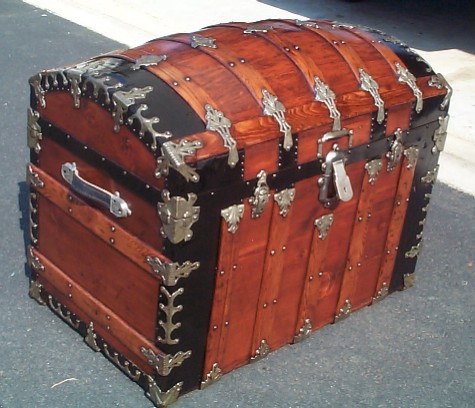
Click Here To Review Sample Engravings |
The Largest Selection of Antique Trunks on the Net to Choose From! |
OPTIONAL - Trunk Wood Engraving Examples and Prices
Custom Designed, Handcrafted, and Hand Lettered in Caligraphy on your Antique Chest |
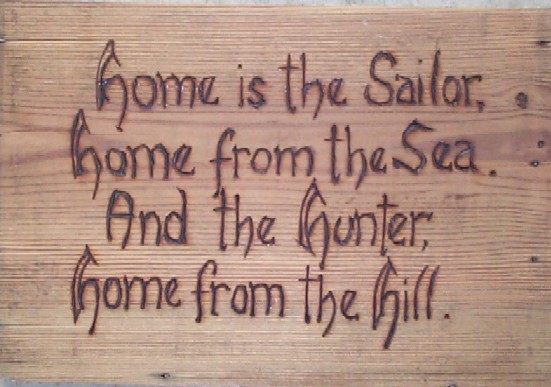
Click Here To Review Sample Engravings |
Personalize Your 100+ Year Old Antique Trunk in Perpetuity! |
Antique Trunks as a Shadow Box and Storage Chest!
Customer Photographic Examples of our Antique Trunks Being used as a Military or Naval Retirement Shadow Box and Storage Chest!! |
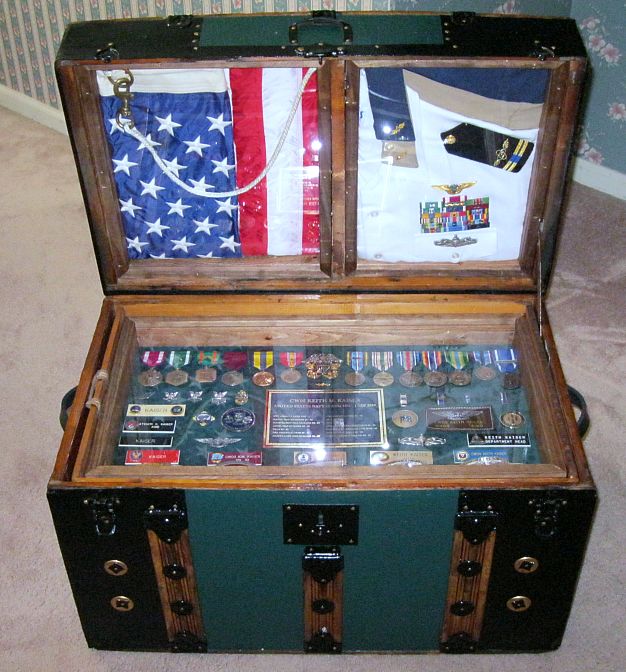
Click Here for Sample Shadow Box Photographs From Customers |
Why just get a shadow box or a newly made trunk with no history! One of our 100+ Year Old Nautical Antique Trunks can be used for both a Shadow Box and Storage Chest for your Uniforms, Photograph Albums, and Memorabilia! |
The Pirate's Lair
Division of DataCity, Inc.
78 Canterbury Drive
Stafford, Virginia 22554
Phone: 540-659-6209
Click Here and Return to The Pirate's Lair Home Page www.thepirateslair.com
"Service Disabled Veteran Owned Small Business"
Or
Email the-pirate@thepirateslair.com


 Or Click HERE to return to The Pirate's Lair Home Page and Gangplank!
Or Click HERE to return to The Pirate's Lair Home Page and Gangplank!
Copyright(c) 2008 All Rights Reserved - Unauthorized downloading, copying or use of any html code, text or images found on this or on any other pages within the www.pirateslair.com website will be prosecuted.
Music Credits: Donald Where's Your Trousers/Drunken Sailor medley by The Bards
ANY TEXT BELOW THIS LINE IS SOLEY FOR THE BENEFIT OF SEARCH BOTS, SPYDERS AND OTHER DENIZENS OF THE DEEP DARK SEA INTERNET
The british naval cutlass was also sometimes known as a navy sword or naval short sword as the blade was sometimes significantly shorter than some of the 30" plus blades found on infantry and calvary swords.
moreover the sweeping blade of the cutlass was called in french m1833 the "falchion" which distiguishes it from the straigher sword blades.





















